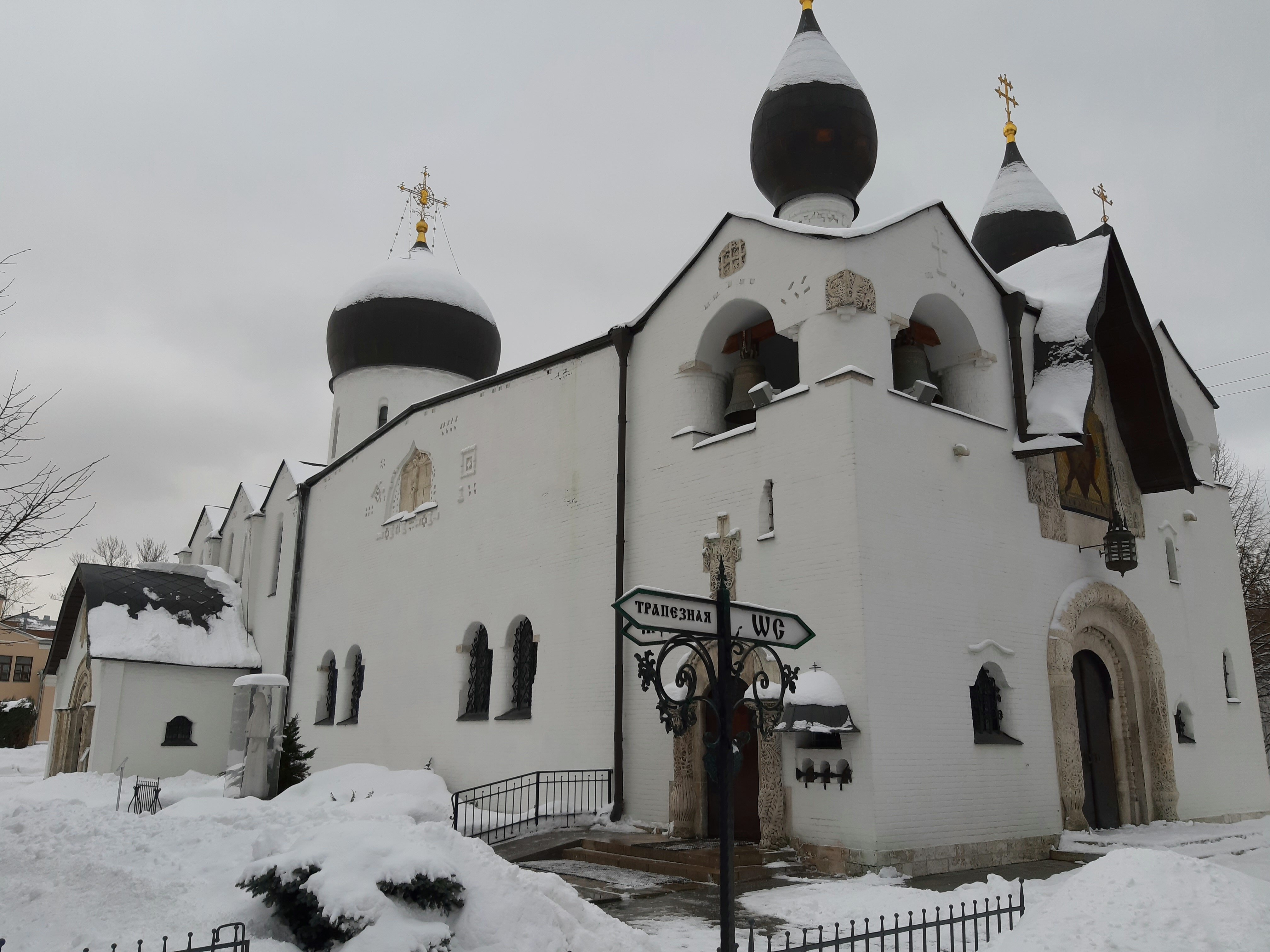Большой белоснежный собор виден через широкую арку с деревянными воротами в такой же белоснежной стене и напоминает средневековую крепость. Мы как будто переносимся на север, в Псков и Новгород. На самом деле возраст храма отнюдь не так велик, как кажется, зато над его созданием работали лучшие мастера своей эпохи. Его самого не существовало бы без воли родной сестры последней русской императрицы.
После убийства в 1905 году генерал-губернатора Москвы великого князя Сергея Александровича его вдова, великая княгиня Елизавета Федоровна, продала часть своих драгоценностей. На полученные средства она приобрела обширную купеческую усадьбу на Большой Ордынке с четырьмя домами и большим садом. На этой основе великая княгиня начала создавать Марфо-Мариинскую обитель милосердия. Она выбрала форму служения, близкую к монастырской жизни, но во многом от нее отличавшуюся. Так, сестры обители принимали на себя ряд обетов, однако не постригались в монашество, они могли со временем выйти из обители и обзавестись семьей. В первую очередь члены общины должны были вести благотворительную деятельность, причем не только в стенах обители, но и за её пределами. Сестер можно было видеть в самых криминальных уголках Москвы, в том числе на знаменитой Хитровке – везде они оказывали медицинскую и духовную помощь, обходили ночлежки, порою сопровождали беспризорных детей в приюты. На официальном открытии обители в 1909 году сестер было всего шесть, но со временем их количество возросло до тридцати.
В большом двухэтажном доме, выходящем на улицу, была устроена больница с палатами и операционной, в мезонине располагались комнаты сестер. Просторное помещение с большими окнами, которое до этого было зимним садом, преобразовали по проекту архитектора Л.В. Стеженского в больничный храм, освященный во имя Марфы и Марии – именно они стали небесными покровительницами новой обители.
Расположение церкви было выбрано таким образом, чтобы больные из своих палат могли видеть и слышать богослужение. В здании слева от больницы был устроен дом настоятельницы с моленной, а справа расположились амбулатория и аптека, в которой лекарства неимущим отпускались бесплатно. Наконец, в четвертом доме, находящемся во дворе, была отведена квартира для священника, исполнявшего обязанности духовника обители, а под нею, в нижних этажах, помещались школа и библиотека для воспитанниц приюта при обители. Со временем здесь же появилась воскресная школа для девушек и женщин, работающих на фабриках, безграмотных и полуграмотных. В 1911 году, когда число сестер увеличилось, архитектор Д.М. Челищев выстроил в стиле неоклассицизма трехэтажное здание для общежития, где также разместилась рукодельная.
Центром Марфо-Мариинской обители стал Покровский собор, строившийся в 1908-1912 годах по проекту знаменитого архитектора А.В. Щусева. Это уникальный образец неорусского стиля в храмовом зодчестве или «русского церковного модерна». Собор ориентируется на новгородские и псковские церкви XII-XIV веков, его стены совершенно белые, длинные и узкие окна закрыты решетками с растительными мотивами. На массивной алтарной апсиде сохранилась закладная доска, сообщающая когда и в чьем присутствии был заложен собор. Фасады украшены только рельефными клеймами, выполненными по проекту С.Т. Конёнкова: они изображают Распятие и Небесный Иерусалим. К основной части собора примыкает обширная трапезная, использовавшаяся не только для богослужений, но и для духовно-просветительских бесед. С запада находятся две звонницы с широкими арочными проемами, каждая из которых увенчана вытянутой главой. Также на западном фасаде расположена мозаичная икона Спаса Нерукотворного, выполненная М.В. Нестеровым. Он же расписал основную часть храма изнутри, создав несколько композиций, самая значительная из которых – «Путь ко Христу». Наконец, еще одним знаменитым создателем собора был П.Д. Корин, кисти которого принадлежат росписи в подземной церкви во имя Бесплотных сил и Всех Святых – предполагалось, что здесь будет усыпальница для сестер обители и для самой основательницы.
После революции и убийства в 1918 году великой княгини Елизаветы Федоровны в Алапаевске Марфо-Мариинская обитель просуществовала недолго. В 1920-х годах в Покровском соборе расположился дом санитарного просвещения, на смену которому пришли реставрационные мастерские. В больничном корпусе с церковью святых Марфы и Марии находилась амбулатория имени профессора Ф.А. Рейна.Возрождение обители началось в 1990 году с открытия памятника великой княгине Елизавете Федоровне работы В.М. Клыкова во дворе обители. Полная передача всего комплекса новой общине происходила достаточно долго, богослужения были возобновлены не сразу (в храме святых Марфы и Марии в 1992 году, а в Покровском соборе – в 2008 году). Однако сегодня обитель живет новой жизнью и следует тому курсу, который был задан еще в дореволюционную эпоху.

















%20BEL_0521.jpg&w=1920&q=75)











